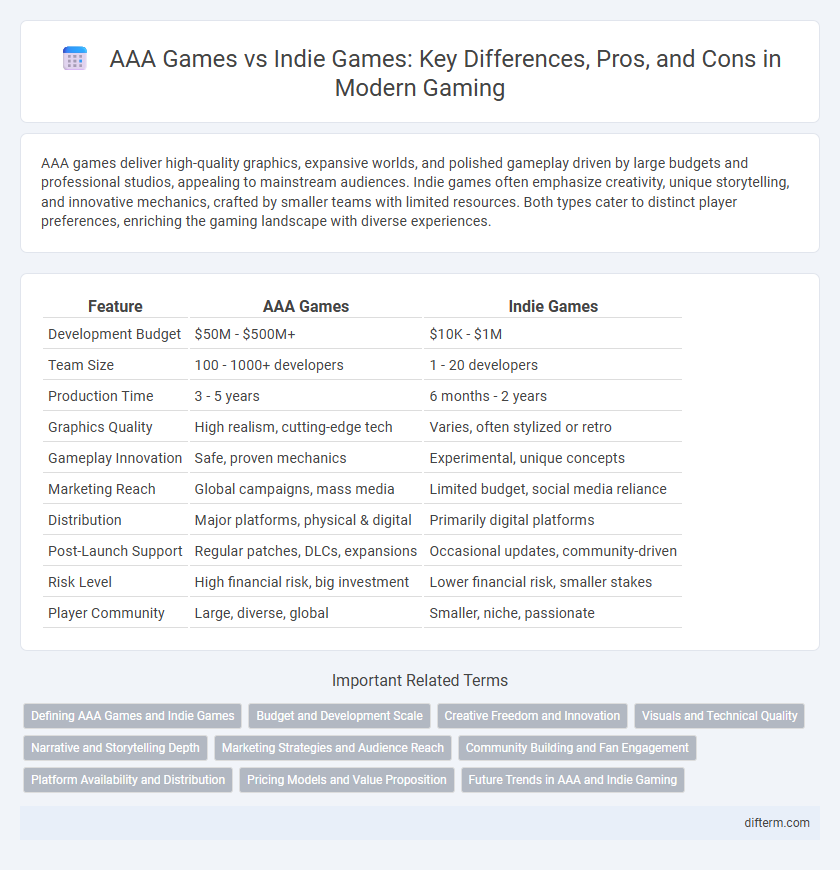AAA games deliver high-quality graphics, expansive worlds, and polished gameplay driven by large budgets and professional studios, appealing to mainstream audiences. Indie games often emphasize creativity, unique storytelling, and innovative mechanics, crafted by smaller teams with limited resources. Both types cater to distinct player preferences, enriching the gaming landscape with diverse experiences.
Table of Comparison
| Feature | AAA Games | Indie Games |
|---|---|---|
| Development Budget | $50M - $500M+ | $10K - $1M |
| Team Size | 100 - 1000+ developers | 1 - 20 developers |
| Production Time | 3 - 5 years | 6 months - 2 years |
| Graphics Quality | High realism, cutting-edge tech | Varies, often stylized or retro |
| Gameplay Innovation | Safe, proven mechanics | Experimental, unique concepts |
| Marketing Reach | Global campaigns, mass media | Limited budget, social media reliance |
| Distribution | Major platforms, physical & digital | Primarily digital platforms |
| Post-Launch Support | Regular patches, DLCs, expansions | Occasional updates, community-driven |
| Risk Level | High financial risk, big investment | Lower financial risk, smaller stakes |
| Player Community | Large, diverse, global | Smaller, niche, passionate |
Defining AAA Games and Indie Games
AAA games are high-budget, high-profile titles developed by large studios with extensive resources, aiming for mass-market appeal and polished graphics, often featuring complex gameplay and expansive worlds. Indie games are created by smaller teams or individual developers, emphasizing innovation, unique artistic styles, and experimental mechanics, usually with limited budgets and niche audiences. The distinction lies in development scale, funding, marketing reach, and production values, impacting game design and player experience.
Budget and Development Scale
AAA games typically have budgets exceeding $50 million and involve large development teams often numbering in the hundreds, enabling high production values and extensive marketing campaigns. Indie games operate with significantly smaller budgets, often under $1 million, relying on small teams or individual developers to create innovative experiences with limited resources. The scale difference influences not only the visual fidelity and complexity but also the risk tolerance and creative freedom during development.
Creative Freedom and Innovation
AAA games often face limitations due to large team coordination and strict publisher guidelines, which can restrict creative freedom and innovation. Indie games, benefiting from smaller teams and fewer financial constraints, frequently push boundaries with unique gameplay mechanics and storytelling approaches. This freedom fosters a dynamic environment where unconventional ideas thrive, driving innovation in the gaming industry.
Visuals and Technical Quality
AAA games typically showcase cutting-edge visuals with high-resolution textures, advanced lighting effects, and complex shaders enabled by substantial budgets and skilled development teams. Indie games often prioritize artistic style and innovative design over photorealistic graphics, using unique visual approaches that distinguish them despite fewer technical resources. While AAA titles push hardware capabilities with polished technical quality, indie games excel in creativity and visual originality, catering to diverse player preferences.
Narrative and Storytelling Depth
AAA games often feature expansive narratives with high production values, leveraging large teams to create immersive storytelling experiences, detailed character development, and complex world-building. Indie games tend to emphasize innovative, personal, and emotionally driven stories, frequently exploring unique themes and unconventional narrative structures that resonate deeply with niche audiences. Narrative depth in indie titles can rival or surpass AAA games by prioritizing substance and creativity over spectacle.
Marketing Strategies and Audience Reach
AAA games leverage extensive marketing budgets, utilizing multi-channel campaigns including TV commercials, social media influencers, and global events to maximize audience reach. Indie games rely heavily on niche communities, grassroots promotions, and platforms like Steam or itch.io to build dedicated fanbases with targeted, authentic engagement. Both strategies adapt to digital trends, but AAA titles dominate mass markets while indies excel in cultivating passionate, smaller communities.
Community Building and Fan Engagement
AAA games leverage extensive marketing budgets and large development teams to create immersive worlds that foster massive fan communities through regular content updates, official forums, and social media engagement. Indie games often build tight-knit, passionate communities by directly interacting with players on platforms like Discord and Twitch, encouraging user-generated content and feedback-driven development. Both approaches cultivate loyalty, but AAA titles excel in broad reach, while indie games thrive on personal connections and grassroots support.
Platform Availability and Distribution
AAA games typically launch across multiple major platforms, including PlayStation, Xbox, and PC, enabling broad market reach and maximizing player accessibility. Indie games often prioritize digital distribution through platforms like Steam, Epic Games Store, and itch.io, which cater to niche audiences and offer lower barriers to entry. While AAA titles benefit from extensive physical and digital retail presence, indie games leverage online marketplaces and community-driven platforms to achieve successful distribution.
Pricing Models and Value Proposition
AAA games typically feature premium pricing models justified by high production values, extensive marketing, and immersive gameplay experiences, offering players a polished and expansive content package. Indie games often adopt flexible pricing strategies such as lower upfront costs, pay-what-you-want models, or frequent sales, providing unique, innovative gameplay and niche storytelling that value creativity over scale. The value proposition differs as AAA titles emphasize cutting-edge graphics and vast worlds, while indie games prioritize originality and artistic expression within more budget-friendly access points.
Future Trends in AAA and Indie Gaming
Future trends in AAA gaming emphasize advanced graphics powered by ray tracing and AI-driven NPC behavior, alongside larger open-world environments and immersive VR integration. Indie games are increasingly leveraging innovative gameplay mechanics and unique storytelling, facilitated by accessible development tools and digital distribution platforms. The convergence of these trends points to a gaming landscape where quality, creativity, and player experience drive both AAA and indie game evolution.
AAA games vs indie games Infographic

 difterm.com
difterm.com